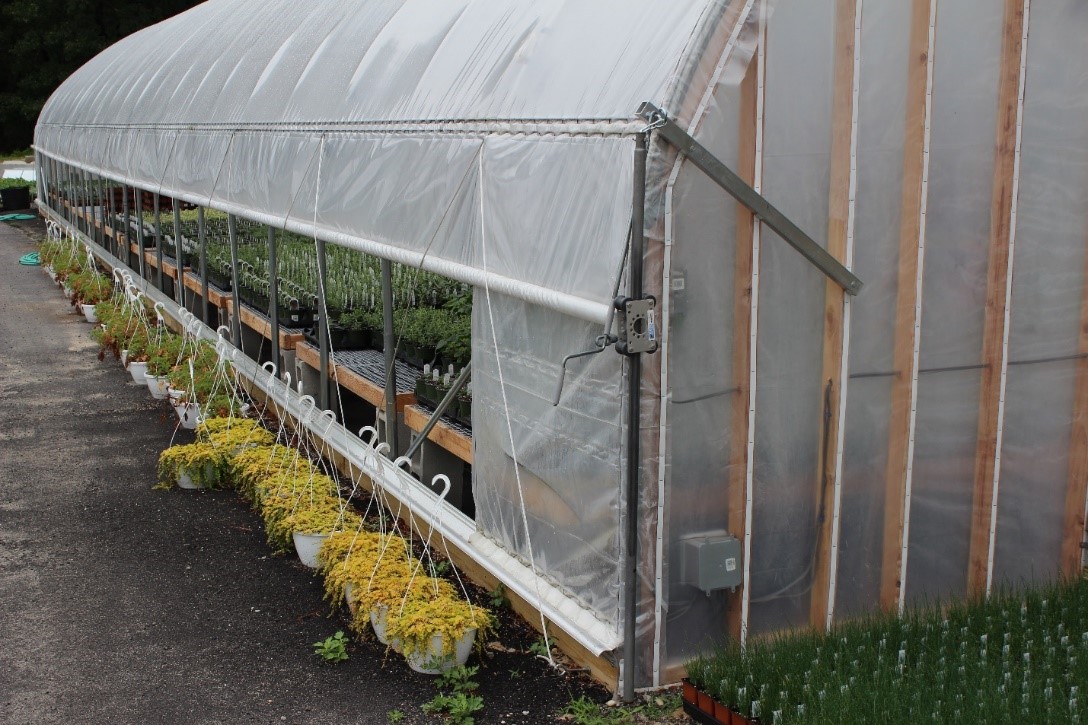We recommend the Guide Pipe Extender Post be positioned above the top curtain clasp (12″ is typical).
On greenhouses, when using manual gear crank operators, the guide pipe and entire operator must be suspended off the end of the structure, so that only the roll-bar will roll against the structure, and the operator will clear the structure by about 2″. You need 6” of clearance when using a Low Voltage Motor.
Determine how you want to mount the guide pipe. By temporarily pivoting the guide pipe from various possible mounting points above the top of the curtain, you can determine the best mounting position for the guide pipe as the operator rolls the curtain up along the arc of the greenhouse.
Determine how far away from the end of the greenhouse the guide pipe should be mounted. Mount the guide pipe as desired and cut to length, if necessary, but allow the guide pipe to extend about 8″ past the lip of the Roll-Lock (if applicable) at this time. It can be cut shorter later, if necessary.
NOTE: It is easy to cut the guide pipe to length with a pipe cutter tool, while attached to the upper mounting point, if you adjust the pipe cutter slightly each revolution.

1. Why does the guide pipe not get anchored at top and bottom?
Freedom of movement in all directions is important for roll-up curtains. The roll-bar follows the contour of the structure, and gets larger as it goes up, and as wrinkles occur, your curtain will shift slightly right and left.
Mounting a guide pipe rigidly at top and bottom will restrict movement unnecessarily and cause it to bind.
And with the Roll-Lock system, the roll-bar must be able to pivot out over the Roll-Lock and rotate back under the Roll-Lock to lock in place.
2. Must the guide pipe be positioned off the end of the structure?
On curved walls, it must be suspended off the side to allow the guide pipe and operator to move freely throughout the opening cycle.
On straight walls, it can be mounted in front of the structure, but you must allow for protecting the end panels behind the operator from being damaged as the operator goes up and down. Under some circumstances, you may have to adapt a pocket for the operator guidewheels to recess back into, or provide a plate, or board between the inflatable end panel and the operator wheels. REMEMBER, unobstructed freedom of movement is important, and with automated motors, it is CRITICAL!
These adaptations are your responsibility, as not every contingency can be provided for in packaged curtain systems.
3. Other manufacturers roll-up curtains were provided with an operator and guide pipe on one end and a set of guidewheels and a guide pipe on the other end. Why does the Advancing Alternatives curtain not have the guide pipe and guidewheels for the other end?
Your curtain’s movement is controlled by the fabric rolling around the Roll-Bar. Guide pipes on the far end only hinder that movement and add an increased downward drag to that end. As long as the wind ropes are in place to hold the curtain against the building during windy times, adding further drag to a system causes more problems than it cures.
4. Why do you recommend a guide pipe mounting extension on hoophouse installations?
On curved walls, as the curtain rolls up, the guide pipe will no longer be hanging down vertically. The weight of the guide pipe that is through and past the upward rolling operator, will add increasing downward pressure on the roll-bar as the curtain continues to climb. Adding the extension lessens the leverage ratio above the operator, placing less guide pipe weight on the operator and rollbar.